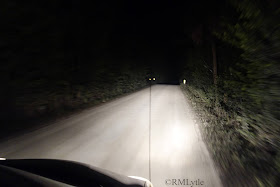When you've been fly fishing for different species as much as I have, you know how random a lifer can find it's way to you or how much time and effort builds up to it. Tarpon will forever be an outlier for me. I'd struggled many times to even get a look from one, had hooked and lost a couple and missed others incidentally, but that didn't feel like a buildup. My first tarpon ever came a mere handful of missed takes into our evening session. Though there was tenseness (there always is when I'm after a species I've wanted for years) I also had this sensation that this time it was going to happen, without question. I've never had that before, and it was a strange feeling. But when I finally connected and that little baby silver prince went airborne, I smiled and new I was about to hold my first ever tarpon. That feeling can't really be earned; these fish, even little, have an exceptional knack for parting ways with a fly. But somehow I just knew. And there I was, smiling down at one of the very few popular game fish that I actually considered one of my most wanted lifers. Caught on a gurgler at sunset in an Everglades backwater... to quote Jose Wejebe, referring to baby tarpon in his own way, "Nice, happy goodness". This little fish had no idea what it meant to me.
 |
| Atlantic tarpon, Megalops atlanticus. Life list fish #163. Rank: species. |
Then, as if Florida wanted to give us exactly what we wanted on our final fishing evening, Noah and I started getting hit by tarpon left and right. He got his lifer shortly after I did then we both proceeded to miss, hook, lose and land a bunch more while darkness settled in and the mosquitoes started to take the stage. Topwater blasts left right and center. Silver princes going airborne. It was worth the wait to experience proper good juvenile tarpon fishing.
Like the small snook we'd been catching all day, I was deeply aware that these little tarpon were the fish of the future. In a day and age where my hope for the future is beat down left and right, these fish give me a glimmer of optimism. In 40 years who knows what the world will look like. I can't conceive of anything less than apocalyptic. Yet, just maybe, one of the very tarpon we released will make it's annual migration as a big adult, and maybe I'll be there to meet it.
A lot of people have called species like American shad "poor man's tarpon" or called tarpon giant shiners. I've grown to hate these sort of analogies with time. Each fish species is distinct, distinct enough to warrant a different a different last name, and though we fisherman may try to describe different species by alluding to others, it falls short. Having now caught tarpon, shad, and a variety of shiner species... tarpon are tarpon, shad are shad, and shiners are shiners. You have to catch each one to really get it. Tarpon had their hooks in me before I ever had a hook in one, and I'll be back after these fish that simply cannot disappoint.
Fish for the love of fish.
Fish for the love of places fish live.
Fish for you.
And stay safe and healthy.
Thank you to my Patrons; Erin, David, John, Elizabeth, Brandon, Christopher, Shawn, Mike, Sara, Leo, and Franky for supporting this blog on Patreon.



























































